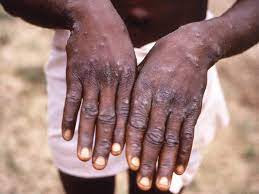Monkeypox Images: What Do Viral Lips Look Like?
As Monkeypox continues to spread - with 12 countries now officially reporting cases - many people still do not know what the outbreak associated with the virus looks like. How do you know if a suspicious outbreak is a monkey?
Although viral monkeypox rash images in humans often look shocking, they remain a rare disease and differ from other pathogens caused by infectious diseases.
Two distinct stages of illness
The World Health Organization (WHO) defines two distinct stages of infection. In the first stage, which lasts for five days, patients develop fever, headaches, swollen lymph nodes, muscle aches, and fatigue. The WHO defines swollen lymph nodes as a distinguishing mark of monkeys from other seemingly identical diseases, such as chicken pox, measles, and smallpox.
Patient closure in the Democratic Republic of Congo, hands showing sores of the genocide Getty virus
In the second stage, usually one to three days after the onset of the flu, the infected person develops rashes on the face and extremities.
In most cases, the virus affects the face, palms and soles of the feet. In most cases, the rash also affects the skin inside the mouth, including the cheeks and lips.
Although the first rash involves flat-base ulcers, these eventually develop into slightly higher, solid ulcers, before filling with clear fluid and eventually forming pustules, which are filled with yellow fluid.
Patient skin showing ulcerative colitis lesions in Liberia, 1971. Getty
People infected with the virus can have anywhere from a few accidents to a few thousand, according to the WHO. Wounds eventually turn into crusts, which dry up and fall off. Monseypox symptoms last between two and four weeks in most people.
Stop showing monmoypox sores on a person's hands. The Getty Images Transmission source of the outbreak is unclear
The current outbreak is concentrated in North America, Europe and Australia, with 92 cases confirmed since May 21. Although a number of recently reported cases have occurred in same-sex couples, WHO and other organizations have emphasized that the disease is not sexually transmitted. it is spread from person to person through close contact with sores, body fluids, respiratory droplets and contaminants such as sleep.
Photo of Centers for Disease Control and Prevention showing monopoly lesions. Getty Photos
Children, adolescents, and those with a weakened immune system are at greater risk for serious complications, according to the European Center for Disease Control (ECDC).
First written by humans in the Democratic Republic of Congo (DRC) in 1970, monkeys are believed to be found in African mice and monkeys. The virus is rarely seen outside central and western Africa, and cases outside those regions are linked to travelers or animals from other countries, according to the U.S. Centers for Disease Control and Prevention (CDC); The outbreak in the US in 2003 was linked to foreign rats from Ghana, who reportedly transmitted the virus to domestic dogs.


No comments